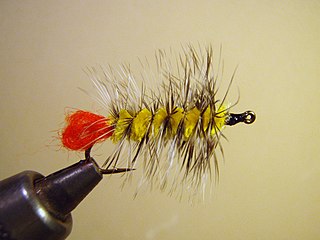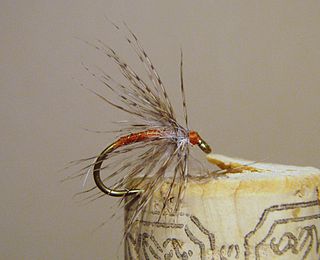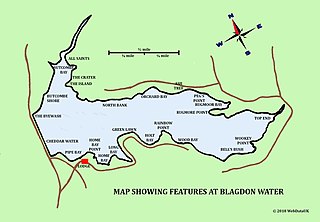Related Research Articles

A fishing rod is a long, thin rod used by anglers to catch fish by manipulating a line ending in a hook. At its most basic form, a fishing rod is a straight rigid stick/pole with a line attached to one end ; however, modern rods are usually elastic and generally have the line stored in a reel mounted at the rod handle, which is hand-cranked and controls the line retrieval, as well as numerous line-restricting rings that distribute bending stress along the rod and help dampening down/prevent line whipping and entanglement. To better entice fish, baits or lures are dressed onto the one or more hooks attached to the line, and a bite indicator is used, some of which might be incorporated as part of the rod itself.

Fly fishing is an angling method that uses a light-weight lure—called an artificial fly—to catch fish. The fly is cast using a fly rod, reel, and specialized weighted line. The light weight requires casting techniques significantly different from other forms of casting. The flies may resemble natural invertebrates, bait-fish, or other food organisms.

A fish hook or fishhook, formerly also called angle, is a hook used to catch fish either by piercing and embedding onto the inside of the fish mouth (angling) or, more rarely, by impaling and snagging the external fish body. Fish hooks are normally attached to a line, which tethers the target fish to the angler for retrieval, and are typically dressed with some form of bait or lure that entices the fish to swallow the hook out of its own natural instinct to forage or hunt.

The Hare's Ear or Gold Ribbed Hare’s Ear is a traditional artificial fly imitating an aquatic insect larva (nymph) used in fly fishing.

Fly tying is the process of producing an artificial fly used by fly fishing anglers to catch fish. Fly tying is a manual process done by a single individual using hand tools and a variety of natural and manmade materials that are attached to a hook. Although the recent history of fly tying dates from the middle 1800s, fly tyers were engaged in tying flys since at least 200 AD.

The Woolly Bugger is an artificial fly commonly categorized as a wet fly or streamer and is fished under the water surface. It is a popular and widely used pattern for both freshwater and saltwater game fish and is generally listed as one of the top patterns to have in any fly box. John Gierach, a noted fly fishing writer discussed the Woolly Bugger first in his chapter on streamers in Good Flies. Woolly Buggers are typically fished in streams, rivers, ponds, lakes, and tidal flats. Today, Woolly Buggers are tied in a wide variety of styles and colors to imitate a wide range of game fish prey.
The Woolly Bugger is so effective, it should be banned from some watersheds. I suspect its effectiveness is due to its resemblance to so many edible creatures in the water—nymphs, leeches, salamanders, or even small sculpins. Its tail undulating behind a fiber, bubble-filled body is just too much for most fish to resist. It just looks like a meal!

The Muddler Minnow is a popular and versatile artificial fly of the streamer type used in fly fishing and fly tying.

Fishing tackle is the equipment used by anglers when fishing. Almost any equipment or gear used in fishing can be called fishing tackle, examples being hooks, lines, baits/lures, rods, reels, floats, sinkers/feeders, nets, spears, gaffs and traps, as well as wires, snaps, beads, spoons, blades, spinners, clevises and tools that make it easy to tie knots.
Dry fly fishing is an angling technique in which the lure is an artificial fly which floats on the surface of the water and does not sink below it. Developed originally for trout fly fishing.

The Pheasant Tail nymph or PT Nymph or Sawyer's Pheasant Tail is a popular all purpose nymph imitation used by fly anglers. It imitates a large variety of olive, olive-brown colored aquatic insect larvae that many fish including trout and grayling feed upon.

An artificial fly or fly lure is a type of fishing lure, usually used in the sport of fly fishing. In general, artificial flies are an imitation of aquatic insects that are natural food of the target fish species the fly fishers try to catch. Artificial flies are constructed by fly tying, in which furs, feathers, thread or any of very many other materials are tied onto a fish hook.
Meaning "little devil", the diawl bach is a popular Welsh fly pattern used in British still waters, and an appropriate lure to use when the fish are feeding on midge pupae. The dressing is simple: size 8 to 14 hook, brown thread, a few barbs of brown hackle for the tail, copper wire, a few barbs of peacock herl for the body, and tying thread for the head.

The Woolly Worm is an artificial fly commonly categorized as a wet fly or nymph and is fished under the water surface. It is a popular pattern for freshwater game fish and was a very popular fly in the 1950s–1970s in the west. Charles Brooks in Nymph Fishing for Larger Trout recommends the Woolly Worm as a general purpose nymph pattern in most western trout waters in any fly box. Woolly Worms are typically fished in streams, rivers, ponds, and lakes for trout, bass, and panfish. Today, Woolly Worms are tied in a variety of styles and colors to imitate a large aquatic nymphs such as stoneflies, dragonflies, damselflies or hellgrammites.
Frank Sawyer MBE (1906–1980) was an English riverkeeper, writer, and inventor of such flies as the Pheasant Tail Nymph. He died in 1980 on the banks of the River Avon at Netheravon.
Fly fishing tackle comprises the fishing tackle or equipment typically used by fly anglers. Fly fishing tackle includes:

The Partridge and Orange is an artificial fly commonly categorized as a wet fly or soft hackle and is fished under the water surface. The fly is a very well known fly with its roots set firmly in English angling history. It is an impressionistic pattern fished successfully during caddis hatches and spinner falls. The Partridge and Orange is traditionally a trout and grayling pattern but may be used for other aquatic insect feeding species.

In fly fishing, Japanese Flies are artificial flies commonly found within many fishermen's tackle box in Japan. In addition to the usual lure variations of fishing grounds chosen by the fishermen and standard materials used in many regions, several differences are seen in the overall construction when compared to Western-style flies. Feathers, yarns and furs are all used, some of the most popular being peacock feathers, chicken down and neck feathers, and black wool. Some flies are even tied with thin copper wire to add extra weight so flies can sink in fast-moving mountain waters. These special flies are mainly used in the Nikkō National Park area near Ashio, Tochigi Prefecture (前日光足尾).

Howard A. Bell (1888–1974) of Wrington was one of the first anglers to adopt an imitative approach to fly fishing on reservoirs in the early twentieth century. At a time when employing flashy 'attractor' patterns was the norm he employed the alternative tactic of using artificial flies that represented the shape and form of the creatures present in Blagdon Water where he fished regularly.
Thomas Coleman Ivens (1921–1988) was an English reservoir fly angler and author.

The Prince Nymph is a nymph attractor wet fly used in fly fishing. It was created by Doug Prince of Oakland, California in the 1930s. It was originally known as the "Brown Forked Tail" and tied without a bead head and used black ostrich herl instead of peacock herl in the body. This fly is weighted. It is productive and popular fly and numerous variations have been created.
References
- 1 2 3 Barr, John. "Tying the Original Copper John". Mid Current. Retrieved March 22, 2021.
- ↑ "Copper John". Evergreen Chapter of Trout Unlimited.
- 1 2 Hunt, Christopher. "The Copper John". Trout Unlimited. Retrieved March 22, 2021.
- ↑ "How to tie the Copper John". Orvis News. Retrieved March 22, 2021.

